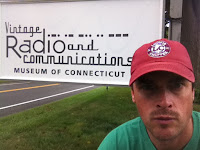- I will learn about cars from the Brass Age.
- What does this museum have to do with Acadia and Mt. Dessert Island?
 I drive a Subaru. I am thus not a "car guy." The Seal Cove Auto Museum made it onto my list simply on account of the limited museums and historical locations in Downeast Maine. So, needless to say, I expected the museum to be little more than a bunch of cars and an altogether short stop. As I pulled in I noticed the car, a '64 Humber with power steering and a 3000 cc engine, that I breathed exhaust from for five miles on the way to Mt. Dessert earlier that morning. In my cynical mindset, I contemplated parking my Subaru on the lawn and putting the hood up for interested passersby to take a look at my 175 hp 2.5-liter engine. But I parked, made my predictions, ventured inside, and ended up spending nearly two hours in the museum.
I drive a Subaru. I am thus not a "car guy." The Seal Cove Auto Museum made it onto my list simply on account of the limited museums and historical locations in Downeast Maine. So, needless to say, I expected the museum to be little more than a bunch of cars and an altogether short stop. As I pulled in I noticed the car, a '64 Humber with power steering and a 3000 cc engine, that I breathed exhaust from for five miles on the way to Mt. Dessert earlier that morning. In my cynical mindset, I contemplated parking my Subaru on the lawn and putting the hood up for interested passersby to take a look at my 175 hp 2.5-liter engine. But I parked, made my predictions, ventured inside, and ended up spending nearly two hours in the museum. It didn't take long to realize that this museum is much much more than a bunch of cars. Aside from the cars themselves, the main exhibit is Auto Wars: Then & Now (1916-2016). The exhibit opened last year corresponding with the 100th anniversary of Acadia National Park but really addresses more than 100 years of auto history on Mt. Dessert Island. The museum was established by collector and auto enthusiast Richard C. Paine Jr. in 1966.
The Auto Wars exhibit tells the very interesting story about the introduction of automobiles to Mt. Dessert and the controversy around that, and takes the story to continuing issues pertaining to automobiles on the Island. America's elite began building summer "cottages" on Mt. Dessert in the late 1800s. These "Rusticators," as they were known, sought a summer escape from the hustle and bustle of their business and in most cases urban lives. The debate about automobiles was very much a battle of class that generally pitted modest locals vs. extravagant summer residents. Locals wanted automobiles for the economic opportunities that would be opened up and the Rusticators wanted quiet to preserve the Eden they desired. From 1900 to 1915, a battle ensued that showed itself in the local papers, in local and state courts, and local and state governments.
To give you and idea of the feelings around the subject one local islander noted that "the coercion exerted on the permanent residents of the town by the wealthy summer residents who wanted to keep autos practically amounted to slavery." Another point out that "If you look beneath the surface you will find the master hand of John d. Rockefeller and his associates. All roads should be opened to all legal vehicles and they have neither the moral no the legal right to keep them closed. At stake is a 22 mile stretch of the most beautiful road in the state. Mr. Rockefeller has asked for a place where he could be exempt from the smell of his own gasoline, to which Rep. Dutton of Bingham replied 'I object to the legislature listening to the rule of a dollar before they hear the call of their own constituents." Even the President at the time, Woodrow Wilson, submitted a view on the debate. A letter from him which pleaded for the prohibition of cars on the island was read at one of the town meetings. You can see the complexities of the conflict around politics, money, class, power, local interest, and technology. By 1915 however, with the coming of the younger, second and third generation Rusticators, the roads were open to automobiles.
The exhibit was set up brilliantly as it utilized primary sources from images to newspaper articles, to more modern video testimony, and an interactive approach that asked viewers where they stand on the issue. The museum even called for suggestions about how to deal with current issues and invited visitors to write them on a large blackboard. Another great thing about this museum is how they took what is for some, the mundane, and put it into an incredibly, egaging, interesting and relevant context.
 |
| One of the beauties on display: 1913 Peugeot |
 |
| Map Showing the divide of no autos in red and permitting autos in green |
















































